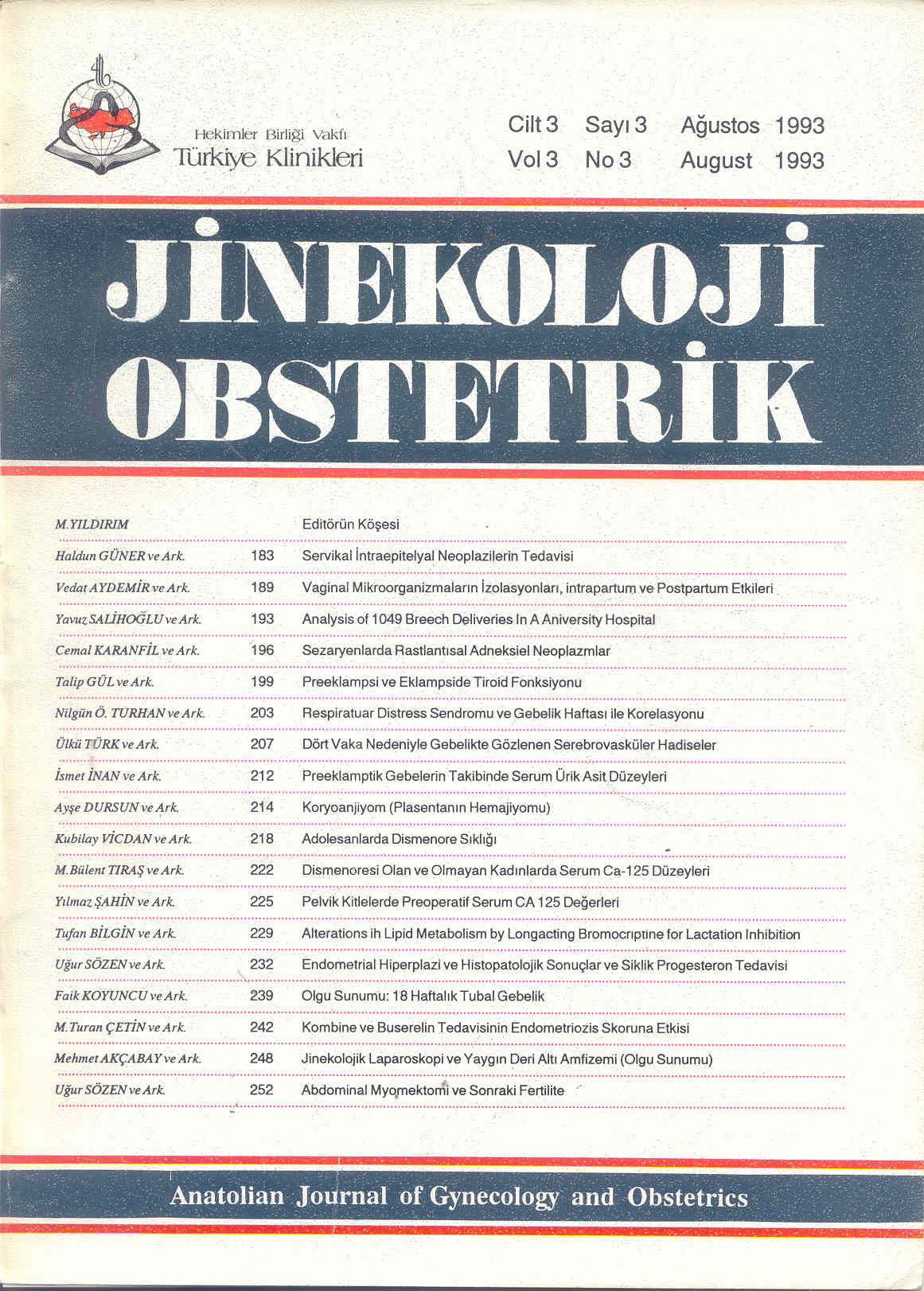Open Access
Peer Reviewed
ARTICLES
2183 Viewed1255 Downloaded
Adolesanlarda Dismonere Sıklığı
Adolesanlarda Dismonere Sıklığı
Turkiye Klinikleri J Gynecol Obst. 1993;3(3):218-21
Article Language: TR
Copyright Ⓒ 2020 by Türkiye Klinikleri. This is an open access article under the CC BY-NC-ND license (http://creativecommons.org/licenses/by-nc-nd/4.0/)
ÖZET
Epidemiyolojik çalışmalar adolesan kızlarda oldukça yüksek dismenore prevalansı göstermesine karşın bu konu Türkiye'de büyük bir adolesan grubunda çalışılmamıştır. Bu çalışmada dismenore prevalansı ve değişik faktörlerle olan ilişkisini araştırmak amacıyla 13-18 yaşları arasındaki 13665 lise öğrencisine anket uygulandı. Adolesanların 10668'i (%78.06) menstruasyon sırasında ağrıdan yakınırken, 2793'ünün (%20.43) ağrısı yoktu. Ağrısı olanların %74.83'ünde ağrı hafifken, %25.6'sı orta ya da şiddetli ağrı nedeniyle sık sık okula devamsızlık yapmaktaydı. Dismenoresi olan adolesanların sadece %0.39'u ağrı nedeniyle doktora başvurmuştu. 13 yaşında %75 olan dismenore oranı 18 yaşında %83.13 olup kronolojik yaşla artmaktaydı. Sosyoekonomik durum ve menstruasyon düzeni ile dismenore arasında ilişki bulunamazken, annenin eğitim düzeyi ve adolesanın sigara içmesi dismenore ile pozitif olarak ilişkili bulundu.
Epidemiyolojik çalışmalar adolesan kızlarda oldukça yüksek dismenore prevalansı göstermesine karşın bu konu Türkiye'de büyük bir adolesan grubunda çalışılmamıştır. Bu çalışmada dismenore prevalansı ve değişik faktörlerle olan ilişkisini araştırmak amacıyla 13-18 yaşları arasındaki 13665 lise öğrencisine anket uygulandı. Adolesanların 10668'i (%78.06) menstruasyon sırasında ağrıdan yakınırken, 2793'ünün (%20.43) ağrısı yoktu. Ağrısı olanların %74.83'ünde ağrı hafifken, %25.6'sı orta ya da şiddetli ağrı nedeniyle sık sık okula devamsızlık yapmaktaydı. Dismenoresi olan adolesanların sadece %0.39'u ağrı nedeniyle doktora başvurmuştu. 13 yaşında %75 olan dismenore oranı 18 yaşında %83.13 olup kronolojik yaşla artmaktaydı. Sosyoekonomik durum ve menstruasyon düzeni ile dismenore arasında ilişki bulunamazken, annenin eğitim düzeyi ve adolesanın sigara içmesi dismenore ile pozitif olarak ilişkili bulundu.
ANAHTAR KELİMELER: Dismenore, adolesan
ABSTRACT
Although the epidemiologic surveys demonstrate a considerably high prevalance of dysmenorrhea in adolescent girls, this subject has not been studied in a large adolescent group in Turkey. In order to investigate the prevalance of dysmenorrhea and its association with different factors, a questionnaier were appired to 13665 adolescent high school girls at the age of 13 to 18. While 10668 (78.06%) of the girls complained from pain during their menstruation, 2793 (20.43%) didn't. Among the girls who had pain during menstruation, the pain was mild 74.83%, and 25.6% of the girls frequently missed school because of moderate or severe pain. Only 0.39% of the adolescents with dysmenorrhea had seeked medical consultation for their pain. The rate of dysmenorrhea was 75% and 83.13% at the ages of 13 and 18, respectively and it was detected to increase with chronologic age. While an association with dysmenorrhea and both socioeconomic status and mestrual pattern was not found. There was a positive connection between dysmenorrhea and mother's education level and smoking of adolescents.
Although the epidemiologic surveys demonstrate a considerably high prevalance of dysmenorrhea in adolescent girls, this subject has not been studied in a large adolescent group in Turkey. In order to investigate the prevalance of dysmenorrhea and its association with different factors, a questionnaier were appired to 13665 adolescent high school girls at the age of 13 to 18. While 10668 (78.06%) of the girls complained from pain during their menstruation, 2793 (20.43%) didn't. Among the girls who had pain during menstruation, the pain was mild 74.83%, and 25.6% of the girls frequently missed school because of moderate or severe pain. Only 0.39% of the adolescents with dysmenorrhea had seeked medical consultation for their pain. The rate of dysmenorrhea was 75% and 83.13% at the ages of 13 and 18, respectively and it was detected to increase with chronologic age. While an association with dysmenorrhea and both socioeconomic status and mestrual pattern was not found. There was a positive connection between dysmenorrhea and mother's education level and smoking of adolescents.
MENU
POPULAR ARTICLES
MOST DOWNLOADED ARTICLES





This journal is licensed under a Creative Commons Attribution-NonCommercial-NoDerivatives 4.0 International License.











